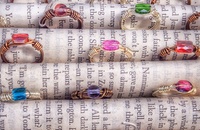
The right piece of jewelry can elevate a plain outfit into something worthy of an editorial spread. But whether you go for bold gold statement necklaces or delicate silver rings, it’s important to consider the qualities and characteristics of fine metal jewelry, especially before making a high-end purchase. This guide outlines the pros and cons of common metal types, and also helps you choose the right necklace chain and length.
Basic Jewelry Metals
There are six main types of metal used to make jewelry:
- Gold
- Rose gold
- White gold
- Platinum
- Sterling silver
- Stainless steel
Gold
Gold is one of the oldest fine metals in the world and certainly the most recognizable. But in its pure state, it’s too soft for jewelry. To boost its strength, it’s mixed—also known as alloyed—with other metals. That’s how you get rose gold and white gold.
| Metal |
The Scoop |
Good to Know |
| Gold |
Won’t tarnish, so it’s long lasting. |
Look for the karat number, the higher the better, to see how much gold is in a piece of jewelry. |
| Rose Gold |
Gets its pinky hue from the copper mixed into it. Most rose gold is about 75% gold and 25% copper. |
Adding copper makes it stronger and more durable than other gold alloys, and also less expensive.
Bonus: The romantic look is very in-demand right now.
|
| White Gold |
An alloy of pure gold mixed with any number of silver-hued metals (silver, nickel, manganese, and palladium are some of the most common). |
It needs to be re-plated every few years to maintain uniform color and shine. |
Platinum, Silver, and Stainless Steel
Platinum is the rarest of the fine metals, and it’s also the most expensive. The cost comes along with benefits, though: platinum is very durable and also hypoallergenic, since it’s not mixed with other metals. Sterling silver and stainless steel have a very similar silver look, but they’re much less expensive.
| Metal |
The Scoop |
Good to Know |
| Platinum |
Very strong and also hypoallergenic. The most expensive choice for jewelry. |
It loses luster over time, so it needs to be cleaned and polished every few years. |
| Sterling Silver |
The closest you’ll get to real silver in modern jewelry. It’s typically 92.5% silver and 7.5% a stronger and more tarnish-resistant metal. |
Not technically a fine metal, but it has the same look as white gold or platinum for a much more affordable price. |
| Stainless Steel |
Made with chromium, which creates an invisible layer of oxide that is naturally corrosion-resistant, or stainless. It’s also the strongest option available. |
It can be a little harder for jewelry makers to work with, but it’s exceedingly durable.
Extra benefit: It’s hypoallergenic because it isn’t combined with the common allergens copper, brass, or nickel.
|

Solid vs. Plating
To get a high-end look without the high-end price, jewelry makers will sometimes plate pieces. To do this, they take a less expensive material, like brass, and cover it with a thin layer of fine metal. This technique is most often used for fashion jewelry because the plating will wear away over time. Plated jewelry is not a good investment for an engagement ring, but it’s ideal if you’re looking for a trendy statement piece.

Karats
Karats with a K is the measure of gold in jewelry. The higher the karat number, the higher the percentage of pure gold, and the more valuable it is.
| Jewelry Stamp |
Percentage of Pure Gold |
| 24K |
100% |
| 18K |
75% |
| 14K |
58.3% |
| 10K |
41.7% |
Necklaces, Chains, and Pendants
Will you be wearing the chain on its own or with a pendant? Do you want the necklace to hit at your sternum or your collarbone? These are just a couple of questions to consider when buying a necklace.
Style
A chain designed to be worn on its own is more likely to be thicker and more intricately woven, like a Byzantine chain. If you’re going to wear a chain with a pendant, a thinner cable or box chain is a better choice.

Length
The most popular chain length is 18” for women and 20” or 24” for men. That’s just long enough to fall in the middle of the average person’s chest. A 16” chain is considered normal for children, but it’ll fit very close to the collarbone on an adult. You can also go much longer; a 30” or 36” chain is great for layering or wrapping.

Pendant Sizing
Because it’s so small, jewelry is almost exclusively measured in millimeters, but that can be hard to visualize without a reference point. Keep these common-coin sizes in mind for your next pendant purchase:
| Coin |
Approximate Diameter |
| Dime |
18mm |
| Penny |
19mm |
| Nickel |
21mm |
| Quarter |
24mm |
| Half Dollar |
30mm |
RELATED READS:
 Gemstone Buying Guide
Gemstone Buying GuideUnderstand the basics of gemstone jewelry and how it can add a colorful, vivid touch to outfits.
 Diamond Buying Guide
Diamond Buying GuideUnderstand a diamond's most important characteristics, so you're confident in the quality and value of your selection.










